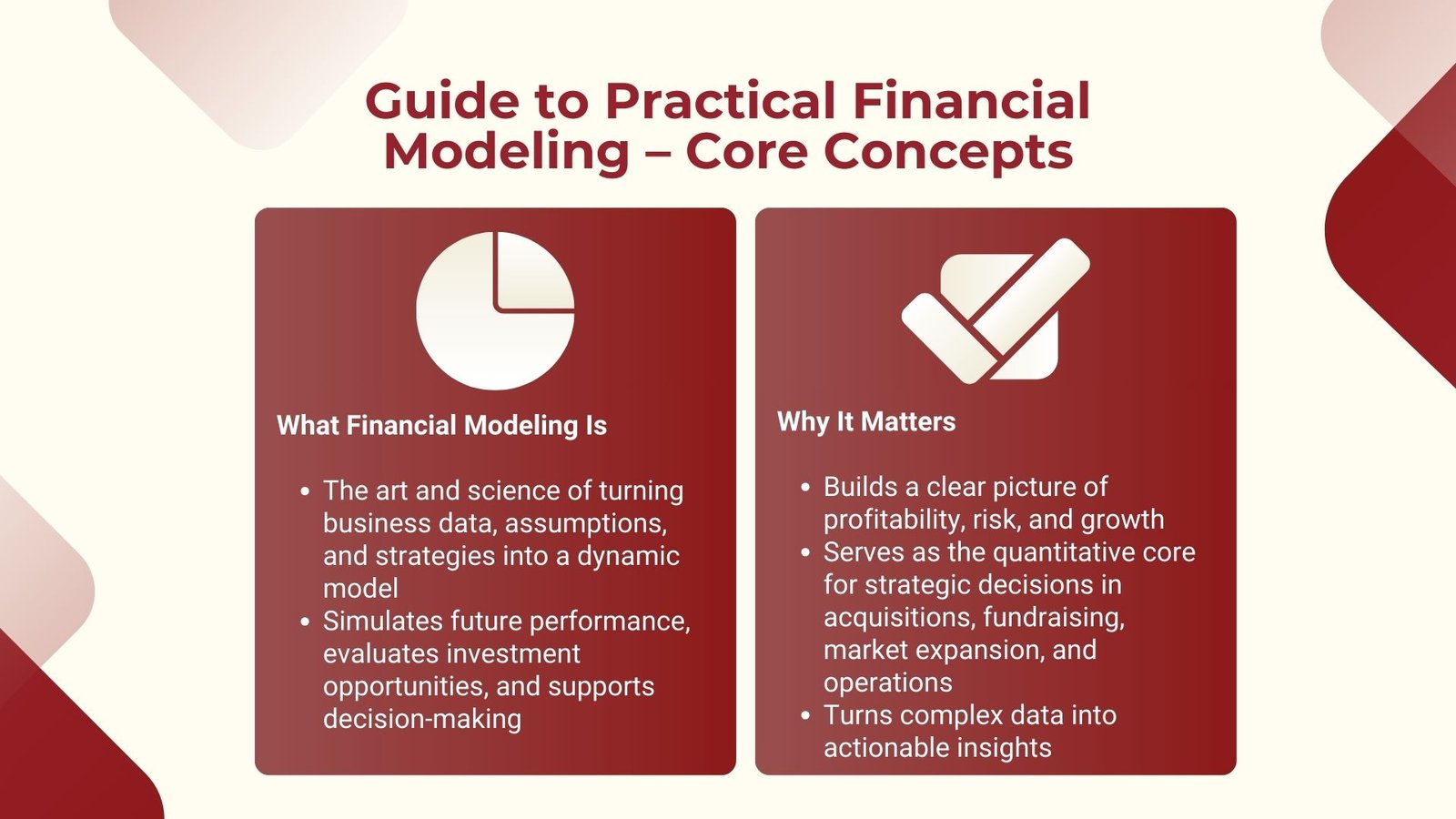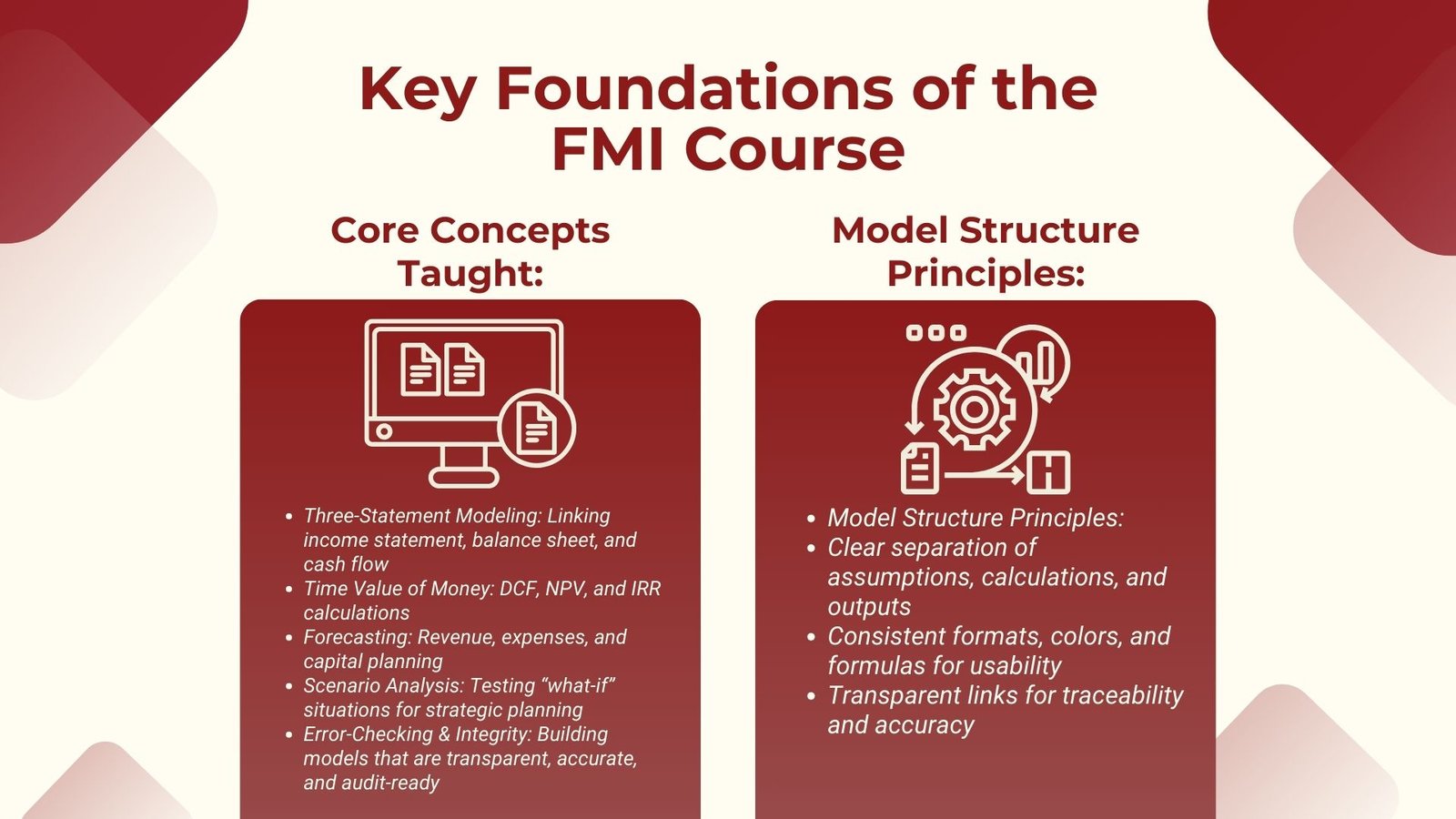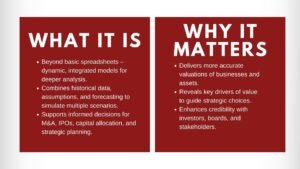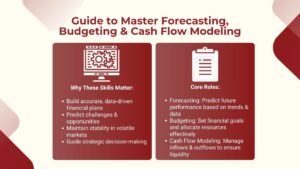
Practical Financial Modeling Core Concepts Course
Guide to Practical Financial Modeling Core Concepts Course
The term financial modeling has emerged among the most significant technical knowledge in the global of the financial professionals, investors, companies owners and analysts. It is the work of art and science of interpreting the financial information, assumptions and business strategies of a company into a model capable of simulating future performance as well as investment opportunities using this model and making decisions based on the same.
Although the phrase might seem to be complicated, the issue of financial modeling is mainly about creating a representation of the numerical illustration of how a business operates and how the performance can potentially develop in future. FMI Foundations program provides an in-depth exploration of foundation principles of this science and provides learners with the chance to create, interpret, and utilize models in a real-life situation.
Ultimately though, financial modeling is not numbers game, it is an exercise on the mechanics of business. The thought process and assumptions that make a model are the only as good as the model is. The FMI Foundations model enables the participants to know why some inputs are important, their interconnection, and what the outputs are capable of telling about the profitability, growth potential, and risk. The participants can have a clear understanding of financial issues when they are equipped with the basic concepts of techniques.
The Role of Financial Modeling in Business Decision-Making
Advanced Financial models for Professionals are important in the corporate finance sector since decision making largely depends on conceptually sound and properly constructed financial models. Financial modeling: Regardless of whether a firm is going through an acquisition, fundraising pitch, market expansion, or a change in operations,Financial modeling is the quantitative core of any decision. The program has been initiated by the FMI Foundations which first clears the circumstances under which models are applied. An investment banker may employ a discounted cash flow (DCF) model to arrive at a fair valuation but a corporate manager may employ an operational model in predicting sales as well as production costs.
Another significance of modeling is that it can formulate complicated financial situations into a simplified structured manner. Trying to derive information only by numbers which are not contextualized may be deceptive or downright unproductive. An effective model does not only arrange the data, but also enables it to test alternative conditions.
What would occur in case sales would increase not 10 percent, but 15 percent? What happens in case of a rise in cost more than expected? This can be achieved by altering the inputs thus enabling decision-makers to see the various outcomes that can be realized without investing. This scenario analysis is the central aspect of the strategic planning and risk management, and it is one of the first competencies presented in the FMI Foundations program.
Understanding the Structure of a Financial Model
The FMI Foundations course attaches great importance to the aspect of teaching the students to organize a model rationally in the order of sequences. The models are not mere spreadsheets with numbers, but they have a logical explanation that reflects on how the financial statements relate to one another. The majority of models are constructed of a chain of interconnected parts of assumptions and drivers, calculation areas and output summaries, e.g., financial statements and key metrics.
The assumptions sheet is the main point to start with and the major variables that have influence on the model are distinctly determined. This could be in the form of revenue growth rates, cost margins, capital expenditures and terms of financing. Decouple assumptions and calculations by keeping them separated One of the most important principles taught in FMI training is decoupling assumptions and calculations, so one can audit a model or adjust all the more easily.
Output: starting with there, the calculations section ties these inputs in order to generate estimates or forecasts of income statements, balance sheets and cash flow statements. Each value in such statements must be traceable to an assumption or a previous calculation resulting in transparency and a lower possibility of error.
The other important aspect is the application of standardized formats and formulas. An effective model will be well structured whereby colors, formulas and layout will be used consistently. This does not only make it easier to use by the original builder but also by any other stakeholders to read and comprehend. Models too easily pass from one professional to another, and perfect design is at least as vital as a perfect calculation.
Core Concepts Covered in FMI Foundations
FMI Foundations course is aimed at making one feel that he/she has mastered the fundamentals of financial modeling. Among the areas of focus, merging of the three basic financial statements namely the income statement, balance sheet, and the cash flow statement is one of them. The interaction between these three statements is also key to understanding since the alteration in any of them is bound to influence the others. Take, for instance, where sales on the income statement increase then accounts receivable on the balance sheet increases and will provide an effect on the operating cash flow.
Time value of money is also addressed in the course and this forms the basis of almost every valuation. This idea acknowledges that one dollar this year has a higher value to that of a future dollar as there is an opportunity cost of capital. Various discounted cash flow methods, internal rate of returns, and net present values are discussed to enable the participants to analyze the appeal of investments.
The other foundation of the program entails forecasting methods. Learners are made to know how revenues can be projected in terms of the market size, growth trend and performance drivers of a firm. They as well discuss forecasting ideas about the expenditure, capital expenditure, and working capital. This is to make sure that the model does predict profitability but also it leads to a faithful reflection of cash requirements and funding demands.
Last but not least, FMI Foundations makes emphasis on error-checking and model integrity. Also an error in a name or a misplaced dot in a formula may misrepresent the findings resulting in a faulty business decision. The program presents methods of auditing models, construction of self-checking mechanisms and discipline in data entry and formula construction.

Applying Financial Modeling Skills in the Real World
Among other differences between the FMI Foundations approach and others, emphasis on practical application can be noted. As opposed to focusing on financial modeling as an abstract academic skill, the program incorporates real-life case study to explain the construction and application of models in business. This is especially true for participants seeking Top financial modeling training Singapore. To give an example, the participants would solve the exercise of valuing a startup, calculating the payback period of a new manufacturing plant or determining the economic soundness of a market expansion.
During such exercises special focus is given to expressing business reality in a quantifiable measurement. It does not only involve knowledge of excel but also needs to understand the industry, competitive forces and the nature of the operating environment of that specific company. As an example, in the model of a retail business, foot traffic, conversion, and the average transaction value will be the most important determinants. To a manufacturing firm, the emphasis can be made on production capacity, material costs and inventory turns. Realizing the practical application of the model by modifying it to the situation occurring in the business, participants are taught to develop tools that actually help in decision-making.
Communication is also emphazised in FMI Foundations curriculum. You can easily have an excellently designed model that is not worthy unless the decision-makers recognize what the model is communicating to them. This implies that one should be able to present his/her findings and share the most crucial results as well as clarify the implications of various situations. Participants gain the skills of summarizing or simplifying complex data into an executive-friendly deliverable (in the form of dashboards, charts and brief narrative summaries).
Building a Career Advantage with FMI Foundations
The art of financial modeling is a talent that can make the career path of an individual gain greater opportunity in various roles pertaining to the field of finance. The skills of building and understanding models are very important in investment banking, in private equity, in corporate finance, in equity research, and even entrepreneurial ventures. Employers like their professionals to not just record information and numbers- they want a person who is able to figure out those numbers and translate them into workable information. This is especially true for those seeking Advanced financial modeling certification Singapore.
The certification provided by FMI Foundations sends signals to the employer that the concerned applicant has gained command in understanding the core concepts and methods of financial modelling. It also shows the ability to create robust and properly constructed models able to survive the critique and be the foundation of large business decisions. This does not just open doors to responsibilities of higher levels but also instills confidence in approaching complex issues in the context of finances.
Moreover, the set of skills acquired during FMI Foundations is not a standalone thing: it is a starting point of constant improvement. These foundations can be supplemented with time as the finance professionals become more experienced in their work and therefore specialize in some areas of modeling including mergers and acquisitions, leveraged buyouts, project finance and high end valuation techniques. Flexibility and capacity to build on modeling skills also are key to long-term relevance in an environment that is rapidly evolving in the financial arena.

Conclusion
By completing the training offered in the FMI Foundations: Core Concepts in Financial Modeling program, the participants will gain the necessary tools in order to make their way through the process of financial decision-making confidently. It closes down the gap between the theory and practice through its emphasis in the designing of specific models, analysis of integrated financial statements, testing scenarios, and its applicability in the real world.
Be it the support of corporate strategy, assessment of investment opportunities, or improvement of individual career development, the command of underlying principles of the financial modelling has a potent edge. What used to be considered more of a technical skill, the capacity to translate realities of the business into a structured, quantitative predictive assessment, is now an essential element of effective modern leadership in an era of the data driven economy.







